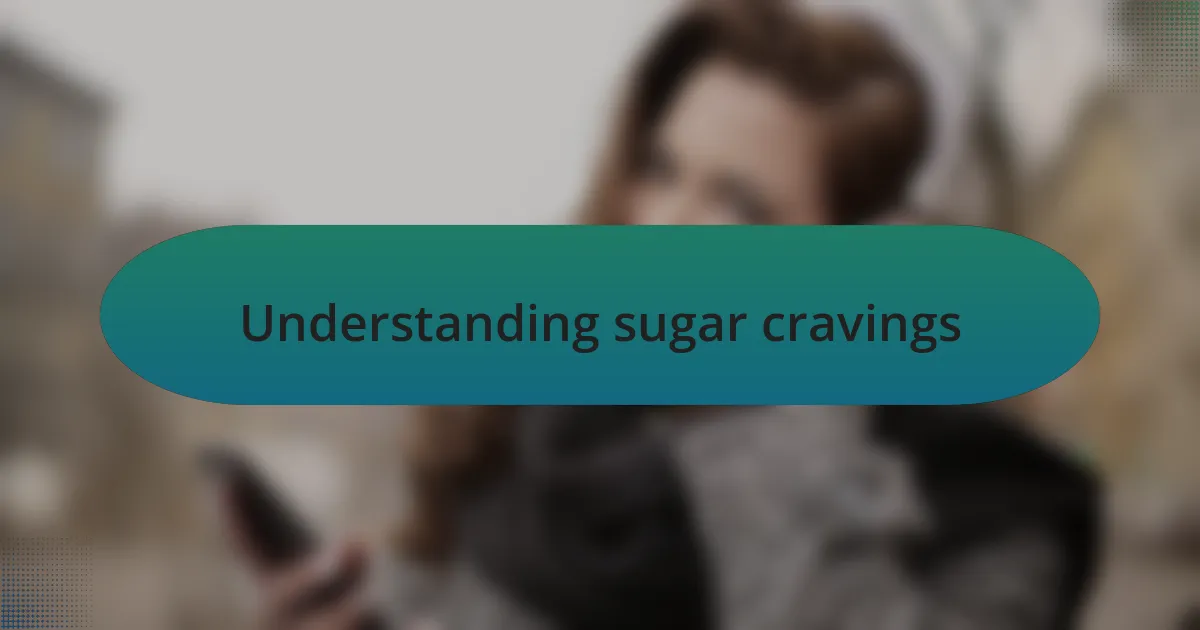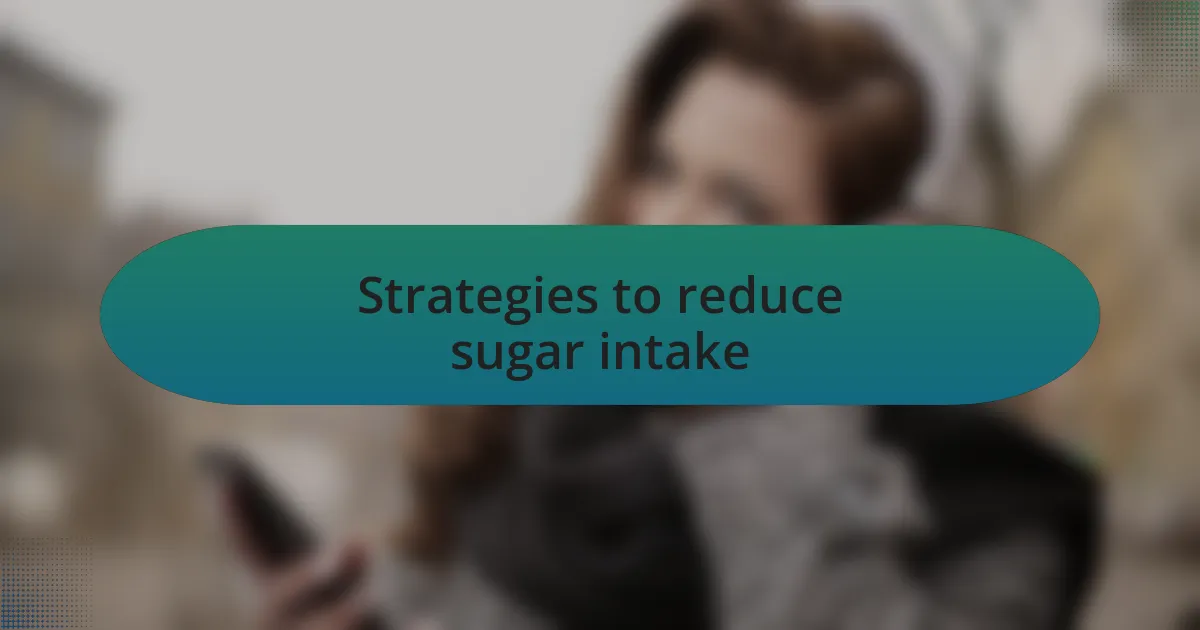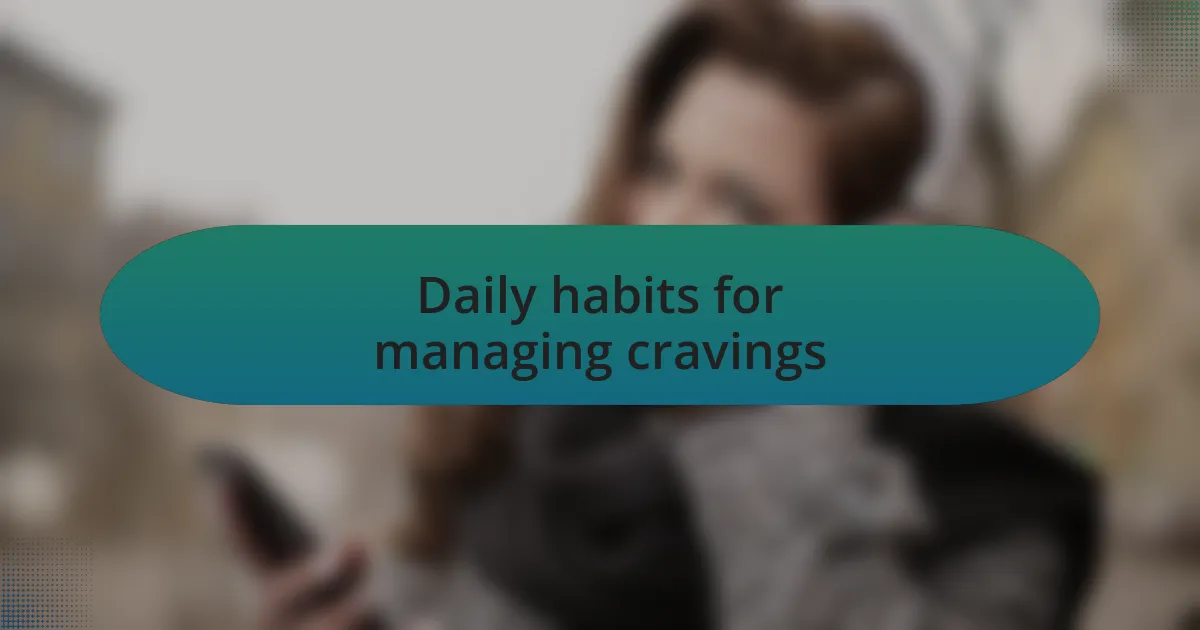Key takeaways:
- Understanding sugar cravings involves recognizing their emotional triggers and neurological aspects, such as dopamine release.
- Reducing sugar intake can improve both physical health and emotional well-being, leading to mood stabilization and a healthier relationship with food.
- Effective strategies include meal prepping, substituting unhealthy snacks with fruits and nuts, and practicing mindfulness during eating.
- Daily habits like maintaining a structured meal schedule, staying hydrated, and incorporating physical activity can significantly help manage cravings.

Understanding sugar cravings
Understanding sugar cravings can be quite the puzzle. I remember sitting on my couch one evening, battling a sudden desire for something sweet. It’s fascinating how these cravings can hit out of nowhere, often tied to emotions or stress rather than actual hunger.
There’s a neurological aspect to sugar cravings that can easily go unnoticed. When I learned that eating sugar triggers a release of dopamine—the feel-good neurotransmitter—I realized why I sometimes craved it after a tough day. Have you ever noticed how a sugary treat can provide a brief escape from reality?
I’ve also found that certain habits can amplify these cravings. For example, when I skip meals or reach for processed snacks, the urge for sugar intensifies. Have you ever experienced a sugar crash after indulging just a little too much? It’s a cycle that can be hard to break, but understanding the root of these cravings helps to regain control.

Impact of sugar on health
Sugar can have profound effects on our health, and I’ve learned this the hard way. For years, I would indulge in sugary snacks without realizing the toll it was taking on my body. Before I knew it, I was caught in a cycle of fatigue and irritability, often seeking solace in yet another sweet treat. It’s eye-opening to think about how these cravings can lead to conditions like obesity or type 2 diabetes over time.
When I started to cut back on sugar, I noticed more than just weight changes; my mood stabilized significantly. There’s something alarming about how sugar can affect our mental health. Have you ever felt a rush of energy after a sugary snack, only to crash moments later? I’ve experienced that rollercoaster first-hand, and it’s not just uncomfortable; it’s actually detrimental to our well-being.
Additionally, I’ve come to realize that sugar impacts not just our physical health but also our emotional state. The guilt that came after overindulging was something I had to deal with regularly. I started asking myself, “Is this fleeting pleasure worth the aftermath?” Rethinking my relationship with sugar has transformed the way I view indulgence, leading me to make healthier choices that support my overall health.

Strategies to reduce sugar intake
One effective strategy I discovered is to substitute sugary snacks with healthier alternatives. I started keeping fresh fruits and nuts on hand, which not only satisfy my cravings but also provide essential nutrients. Have you ever noticed how a juicy apple can be just as satisfying as a candy bar? It really shifts your perspective on sweet snacks when you find natural options that offer the same crunch and sweetness.
Planning ahead has also made a significant difference in my sugar reduction journey. I began meal prepping, which helped me avoid last-minute decisions that often led to sugary snacks. The first time I organized a week’s worth of meals, I felt a sense of accomplishment that transformed my relationship with food. It’s amazing how a little preparation can keep those cravings at bay.
Additionally, I learned to read labels diligently. Initially, I was shocked to find sugar hiding in places I least expected, like salad dressings and bread. This eye-opening experience made me more mindful of what I was consuming. Have you ever checked a product only to find it loaded with sugar? Understanding what’s in our food is crucial, as it empowers us to make better choices consistently.

My journey with sugar cravings
My journey with sugar cravings began in a rather unexpected place—a late-night binge on ice cream while mindlessly scrolling through social media. I remember feeling a rush of happiness with each spoonful, but it quickly turned into regret. Have you ever experienced that fleeting joy followed by an overwhelming wave of guilt? It took me a while to realize that my cravings were more about comfort than hunger, prompting me to rethink my relationship with sweets.
As my understanding deepened, I started to notice patterns in my cravings. There were days when stress or boredom would trigger a strong desire for sugar. One specific afternoon, after a long meeting, I found myself reaching for a chocolate bar without even thinking twice. Acknowledging these emotional triggers was a game changer for me. I began to ask myself, “What am I really craving right now?” Instead of defaulting to sweets, I sought healthier outlets—like going for a walk or sipping herbal tea.
In time, I learned that cravings ebb and flow, much like waves in the ocean. Reflecting on this, I realized that it’s perfectly normal to experience intense urges. There were moments when resisting felt like an uphill battle, but I discovered that allowing myself small indulgences, like a piece of dark chocolate, actually made it easier to stay on track. Have you ever considered that moderation could be more empowering than deprivation? This mindset not only helped me manage my cravings but also turned each small win into a celebration of my progress.

Techniques I found effective
One technique that worked wonders for me was keeping a food journal. Initially, I was skeptical—would writing down my food choices really make a difference? But as I began to log my meals and cravings, I quickly noticed patterns. I could see how certain emotions, like stress or sadness, would coincide with my sugar desires. It was eye-opening, and I felt empowered by gaining that clarity.
Another effective strategy was to substitute sweets with healthier snacks. I used to reach for cookies or candy when the afternoon slump hit. Then I tried keeping fresh fruit or mixed nuts on hand. A simple banana or a handful of almonds often satisfied that sweet craving without the guilt. Did I miss the sugar? Sometimes, yes, but I reminded myself that these choices were nurturing my body, not just pacifying my mind.
Mindfulness during snack times became a game changer as well. I started savoring each bite, really focusing on the flavors and textures instead of mindlessly munching while watching TV. By practicing this, I found that the cravings didn’t feel as overwhelming. Have you ever thought about how much more satisfying a single piece of chocolate can be if you truly savor it? I learned to appreciate the small pleasures, which made it easier to resist the urge to overindulge.

Daily habits for managing cravings
One habit that proved invaluable for managing my cravings was creating a structured meal schedule. I discovered that when I allowed myself to get too hungry, those sugar cravings would creep in like clockwork. I remember one particularly challenging day—I had skipped breakfast and by 11 a.m. I was ready to devour anything sweet in sight. By simply planning my meals and sticking to consistent times, I kept those cravings at bay and felt more in control throughout the day.
Another daily practice I adopted was hydration. I often overlooked how much water impacted my craving levels. There were moments when I mistook thirst for hunger, leading me straight to sugary snacks. One afternoon, after downing a glass of water, I realized that my intense craving for chocolate dissipated significantly. Isn’t it fascinating how something as simple as staying hydrated can influence what we think we need?
I also found that incorporating movement into my routine made a noticeable difference. Whenever I felt a craving bubbling up, taking a brisk walk or doing a quick set of stretches transformed my mindset. I vividly recall feeling the urge to snack while working at my desk. Instead of reaching for candy, I stepped outside for a few minutes, and by the time I returned, I felt refreshed and the craving had vanished. It makes you wonder how much power simple physical activity can have over our desires, right?